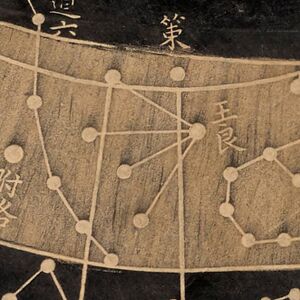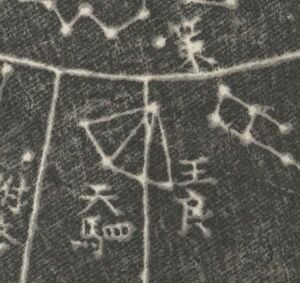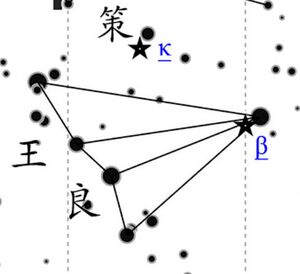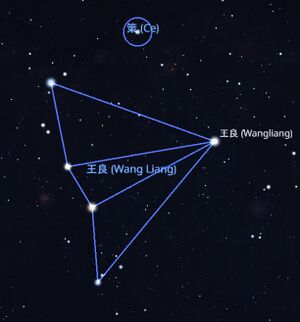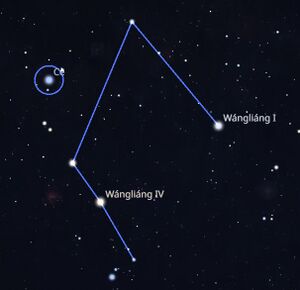Ce: Difference between revisions
Boshunyang (talk | contribs) No edit summary |
Boshunyang (talk | contribs) No edit summary |
||
| Line 1: | Line 1: | ||
{{DISPLAYTITLE: Ce (策)}} |
{{DISPLAYTITLE: Ce (策)}} |
||
[[File:Qin bronze chariot.jpg|thumb|Bronze chariot in Qin dynasty (220 BCE -206 BCE) with four hourses]] |
|||
Tiān Sì (Heavenly Quadriga, 天駟) comprises four of the five stars forming the constellation [[Wangliang]] and represents the four horses pulling the chariot. It may thus be regarded as a constituent sub-constellation/asterism of [[Wangliang]]. |
|||
Cè (Whip, 策) is a Chinese star name representing the horsewhip, located beside the asterism ''[[Wangliang]]'' and closely associated with both ''[[Wangliang]]'' and [[Tiansi.|''Tiansi''.]] It belongs to the Gān school. |
|||
| ⚫ | |||
Given the intimate cultural association between Tiansi and Wangliang, the two must have been conceived simultaneously. In their earliest stage, however, they might be regarded as distinct constellations, as recorded in the ''Tianguan shu'' (Book of Heaven Officials, 天官書). Only later, in the ''Shishi xing jing'' (Shi’s Star Canon, 石氏星經) later , were they formally unified into a single constellation under the name Wang Liang. Nevertheless, even long after their amalgamation, tradition continued to recognize the leftmost four stars of Wangliang as the “Quadriga” and some star map explicitly marked them as Tian Si. |
|||
| ⚫ | |||
It should be noted that the lodge Fang (the fourth of the Twenty-Eight Lodges) also bore the alternate name Tian Si (“Heavenly Quadriga”), a designation that had already been in use at least as early as the late sixth century BCE—earlier than the historical figure of Wang Liang himself. The only difference lies in that Fang comprises four stars representing the quadriga, yet it lacks a corresponding charioteer such as Wang Liang. |
|||
The original meaning of ''ce'' refers to a bamboo horsewhip with a pointed tip, and as a verb it can mean “to whip” or “to drive.” In the ''Tiangaun shu'' (Book of Heaven Officials, 天官書)of the Western Han, it is said that “When Wang Liang drives his horses, the (war) chariots will fill the fields.” It is uncertain whether the ''Ce'' star had already been defined when this divinatory statement was composed (since the ''Gān Star Catalogue'' was completed around the same time or slightly later than Sima Qian’s work). However, the Eastern Han scholar Song Jun connected the phenomenon of “driving horses” with the ''Ce'' star, writing: “The ''Ce'' star is beside ''Wang Liang''; if it moves ahead of ''Wang Liang'', behind the horses, this is called ‘driving the horses.’” A Tang commentary in the ''Kaiyuan zhanjing'' adds: “There is a star beside ''Wang Liang'' called ''Ce''; ‘driving the horses’ means that this star shines brightly.” These differing interpretations reflect what was considered an anomalous phenomenon in ancient Chinese stellar divination—namely, the apparent motion or brightness variation of a fixed star. |
|||
=== Identification of stars === |
=== Identification of stars === |
||
{| class="wikitable" |
{| class="wikitable" |
||
!Star Names |
!Star Names |
||
!Orders(Qing) |
|||
!Ho PENG YOKE<ref>P.-Y. Ho, “Ancient And Mediaeval Observations of Comets and Novae in Chinese Sources,” ''Vistas in Astronomy'', 5(1962), 127-225.</ref> |
|||
!Yi Shitong<ref>Yi Shitong伊世同. ''Zhongxi Duizhao Hengxing Tubiao''中西对照恒星图表1950. Beijing: Science Press.1981: 56.</ref> |
!Yi Shitong<ref>Yi Shitong伊世同. ''Zhongxi Duizhao Hengxing Tubiao''中西对照恒星图表1950. Beijing: Science Press.1981: 56.</ref> |
||
Based on catalogue in 18th century |
Based on catalogue in 18th century |
||
| Line 24: | Line 19: | ||
Song Jingyou(1034) |
Song Jingyou(1034) |
||
|- |
|- |
||
|Ce |
|||
|[[Wangliang]] (Determinative) |
|||
| ⚫ | |||
|1st |
|||
| |
|kappa Cas |
||
| |
|kappa Cas |
||
|beta Cas |
|||
|beta Cas |
|||
|beta Cas |
|||
|beta Cas |
|||
| ⚫ | |||
| rowspan="4" |Tiansi |
|||
|2nd |
|||
|kappa Cas |
|kappa Cas |
||
|kappa Cas |
|kappa Cas |
||
| ⚫ | |||
|gamma Cas |
|||
|gamma Cas |
|||
|gamma Cas |
|||
| ⚫ | |||
|3rd |
|||
|gamma Cas |
|||
|eta Cas |
|||
|eta Cas |
|||
|eta Cas |
|||
|eta Cas |
|||
|eta Cas |
|||
| ⚫ | |||
|4th |
|||
|eta Cas |
|||
|alpha Cas |
|||
|alpha Cas |
|||
|alpha Cas |
|||
|alpha Cas |
|||
|alpha Cas |
|||
|- |
|||
|5th |
|||
|alpha Cas |
|||
|lambda Cas |
|||
|zeta Cas |
|||
|zeta Cas |
|||
|zeta Cas |
|||
|zeta Cas |
|||
|} |
|} |
||
=== Maps (Gallery) === |
=== Maps (Gallery) === |
||
The ''Ganshi zan (Annotations of Master Gan)'' states: “''Ce'' resides at the right of thr charioter.” This description is not entirely precise, as ''Ce'' is most likely refers to the Kappa Cas, the only bright star at the right side of Wang Liang and horses (relative to the forward direction of the horses), which located to the front-right of the charioteer (''Wang Liang''). Nevertheless, in several historical star maps, ''Ce'' is indeed drawn to the right of ''Wang Liang'', showing a certain conceptual consistency. |
|||
{| class="wikitable" |
{| class="wikitable" |
||
|+Wangliang and Ce |
|||
|+ |
|||
!historical map |
!historical map |
||
!modern identification |
!modern identification |
||
(Yang 2023) |
(Yang 2023) |
||
!same in Stellarium 24.4 |
!same in Stellarium 24.4 |
||
| ⚫ | |||
|[[File:Wangliang and Ce in Cheonsang Yeolcha Bunyajido.jpg|thumb|Wangliang and Ce in ''Cheonsang Yeolcha Bunyajido'']] |
|||
| ⚫ | |||
| ⚫ | |||
|- |
|- |
||
|[[File:Wangliang and Ce in Suzhou Star Map.jpg|thumb|Wangliang in Suzhou Star Map]] |
|[[File:Wangliang and Ce in Suzhou Star Map.jpg|thumb|Wangliang in Suzhou Star Map]] |
||
Revision as of 10:19, 9 November 2025
Cè (Whip, 策) is a Chinese star name representing the horsewhip, located beside the asterism Wangliang (王良) and closely associated with both Wangliang (王良) and Tiansi. It belongs to the Gān school.
Concordance, Etymology, History
The original meaning of ce refers to a bamboo horsewhip with a pointed tip, and as a verb it can mean “to whip” or “to drive.” In the Tiangaun shu (Book of Heaven Officials, 天官書)of the Western Han, it is said that “When Wang Liang drives his horses, the (war) chariots will fill the fields.” It is uncertain whether the Ce star had already been defined when this divinatory statement was composed (since the Gān Star Catalogue was completed around the same time or slightly later than Sima Qian’s work). However, the Eastern Han scholar Song Jun connected the phenomenon of “driving horses” with the Ce star, writing: “The Ce star is beside Wang Liang; if it moves ahead of Wang Liang, behind the horses, this is called ‘driving the horses.’” A Tang commentary in the Kaiyuan zhanjing adds: “There is a star beside Wang Liang called Ce; ‘driving the horses’ means that this star shines brightly.” These differing interpretations reflect what was considered an anomalous phenomenon in ancient Chinese stellar divination—namely, the apparent motion or brightness variation of a fixed star.
Identification of stars
| Star Names | Yi Shitong[1]
Based on catalogue in 18th century |
Pan Nai[2]
based on Xinyixiangfayao Star Map and Huangyou Catalogue |
SUN X. & J. Kistemaker[3]
Han Dynasty |
Boshun Yang[4]
before Tang dynasty |
Boshun Yang[4]
Song Jingyou(1034) |
|---|---|---|---|---|---|
| Ce | gamma Cas | kappa Cas | kappa Cas | kappa Cas | kappa Cas |
Maps (Gallery)
The Ganshi zan (Annotations of Master Gan) states: “Ce resides at the right of thr charioter.” This description is not entirely precise, as Ce is most likely refers to the Kappa Cas, the only bright star at the right side of Wang Liang and horses (relative to the forward direction of the horses), which located to the front-right of the charioteer (Wang Liang). Nevertheless, in several historical star maps, Ce is indeed drawn to the right of Wang Liang, showing a certain conceptual consistency.
| historical map | modern identification
(Yang 2023) |
same in Stellarium 24.4 |
|---|---|---|
Star Name Discussion (IAU)
In 202x, the name of the historical constellation "xxx" was suggested to be used for one of the stars in this constellation. ...
Decision: ...
References
- ↑ Yi Shitong伊世同. Zhongxi Duizhao Hengxing Tubiao中西对照恒星图表1950. Beijing: Science Press.1981: 56.
- ↑ Pan Nai潘鼐. Zhongguo Hengxing Guance shi中国恒星观测史[M]. Shanghai: Xuelin Pree. 1989. p226.
- ↑ Sun Xiaochun. & Kistemaker J. The Chinese sky during the Han. Leiden: Brill. 1997, Pp241-6.
- ↑ 4.0 4.1 B.-S. Yang杨伯顺, Zhongguo Chuantong Hengxing Guance Jingdu ji Xingguan Yanbian Yanjiu 中国传统恒星观测精度及星官演变研究 (A Research on the Accuracy of Chinese Traditional Star Observation and the Evolution of Constellations), PhD thesis, (Hefei: University of Science and Technology of China, 2023). 261.
